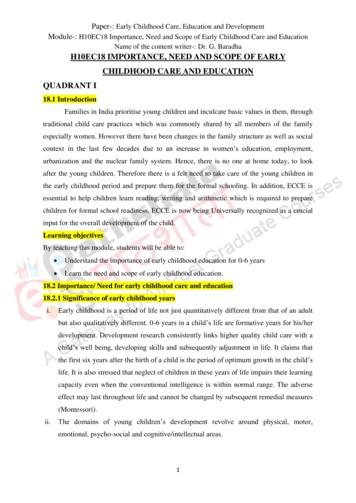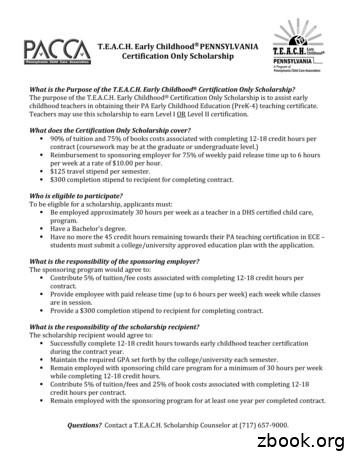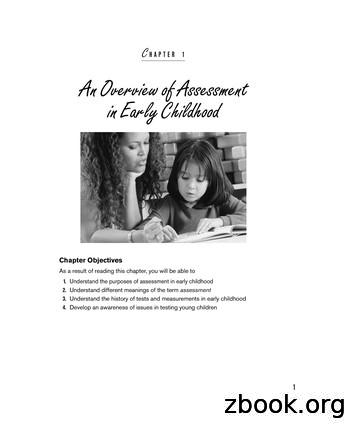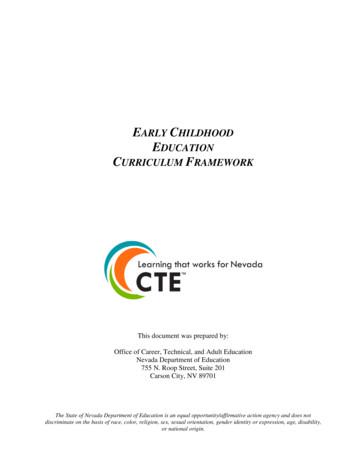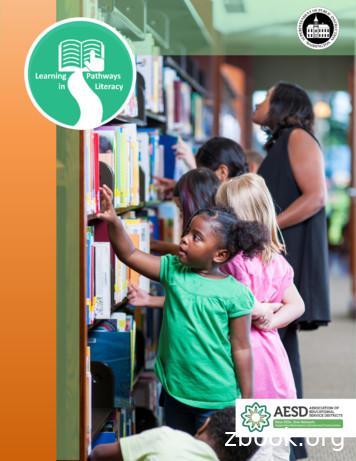Literacy In Early Childhood And Primary Education (3-8 Years)
Research Report No. 15Literacy in Early Childhoodand Primary Education(3-8 years)Eithne Kennedy, Elizabeth Dunphy, Bernadette Dwyer,Geraldine Hayes, Thérèse McPhillips, Jackie Marsh,Maura O’Connor, Gerry Shiel.
Boyd Freeman Designwww.boydfreeman.ieboyd@boydfreeman.ie 353 (0)87 0536995
Literacy in Early Childhood andPrimary Education(3-8 years)Commissioned research reportEithne Kennedy, St. Patrick’s College, DublinElizabeth Dunphy, St. Patrick’s College, DublinBernadette Dwyer, St. Patrick’s College, DublinGeraldine Hayes, St. Patrick’s College, DublinThérèse McPhillips, St. Patrick’s College, DublinJackie Marsh, University of Sheffield, UKMaura O’Connor, St. Patrick’s College, DublinGerry Shiel, Educational Research Centre, Dublin2012Research conducted on behalf of theNational Council for Curriculum and Assessment
Literacy in Early Childhood and Primary Education (3-8 years) NCCA 2012ISSN 1649-3362National Council for Curriculum and Assessment24, Merrion Square, Dublin 2.www.ncca.ie
Literacy in Early Childhood and Primary Education (3-8 years)AcknowledgementsThe Education and Special Education Departments in St. Patrick’s College, Dublin CityUniversity, the Educational Research Centre, St. Patrick’s College and the University of Sheffield,UK, thank the National Council for Curriculum and Assessment for commissioning andsupporting this project. In addition, we are indebted to Sarah FitzPatrick and Arlene Forster ofthe NCCA for providing detailed feedback on earlier drafts of the report.Reading NoteReaders should note that this report is one of three research papers published in 2012 insupport of the development of a new primary language curriculum, as Nos. 14, 15, and 16 inthe NCCA’s Research Report Series (ISSN 1649-3362): Oral Language in Early Childhood and Primary Education (3-8 years) Drs. GerryShiel, Áine Cregan, Anne McGough and Peter Archer Literacy in Early Childhood and Primary Education (3-8 years) Drs. Eithne Kennedy,Elizabeth Dunphy, Bernadette Dwyer, Geraldine Hayes, Thérèse McPhillips, Jackie Marsh,Maura O’Connor and Gerry Shiel Towards an Integrated Language Curriculum for Primary Schools (3-12 years) Dr.Pádraig Ó Duibhir and Prof. Jim CumminsIn recognition of the many important links between their subject matter, especially betweenthe Oral Language and Literacy papers, a measure of cross-referencing has been brought tothe reports. This has been achieved through: a cross-referencing table, included as Appendix C, showing where corresponding orrelated material appears in the companion report/s the inclusion of embedded hyperlinks in the Portable Document Format (PDF) of thereports.The three reports are also published in Portable Document Format (PDF) on the NCCAwebsite at: http://www.ncca.ie along with a series of podcasts of key messages from thereports.
Literacy in Early Childhood and Primary Education (3-8 ention Deficit Hyperactivity DisorderAlphabet KnowledgeBasic Interpersonal Communication SkillsCognitive Academic Language ProficiencyContent and language integrated learningConcept Orientated Reading InstructionComprehensive Test of Phonological ProcessingDelivering Equality of Opportunity in SchoolsDepartment of Education and Skills (formerly Department of Education and Science)Department for Education and Skills (UK)Department for Education and Employment (UK)Department for Children Schools and Families (UK)English as an Additional LanguageEmotional Behavioural DisordersEnglish language learnersEnhanced Milieu TeachingEffective Preschool and Primary EducationFluency Orientated Reading InstructionGeneral Learning DisabilitiesInformation and Communication TechnologiesIndividual Education PlanInternational Reading AssociationInitiation-Response-Evaluation modelNational Association for the Education of Young ChildrenNational Council for Curriculum and AssessmentNational Council for Special EducationUS National Early Literacy PanelNational Institute of Child Health and Human DevelopmentNew Literacy StudiesOrganisation for Economic Cooperation and DevelopmentOral Recitation LessonOpportunities Recognition Interaction ModelsPhonological AwarenessPervasive Developmental DisordersProgramme for International Assessment of Adult CompetenciesProgramme for International Student AssessmentProgress in Reading Literacy StudyPrimary School English Curriculum (1999)Questioning the AuthorQuestion Answer RelationshipsRaising Early Achievement in LiteracyRand Reading Study GroupSpecial Education NeedsSocioeconomic StatusSpecific Learning DisabilitiesSchool Support ProgrammeTreatment and Education of Autistic and Related Communication-Handicapped ChildrenVisual Auditory Kinaesthetic TactileZone of Proximal Development
Literacy in Early Childhood and Primary Education (3-8 years)ContentsExecutive Summary . . . . . . . . . . . . . . . . . . . . . . . . . . . . . . . . . . . 9Introduction: Contextual Framework . . . . . . . . . . . . . . . . . . . . . . . 27Chapter 1: Defining Literacy . . . . . . . . . . . . . . . . . . . . . . . . . . . . 37Chapter 2: Theoretical Perspectives . . . . . . . . . . . . . . . . . . . . . . . . 47Chapter 3: Stages of Literacy Development . . . . . . . . . . . . . . . . . . . 73Chapter 4: Literacy Pedagogy . . . . . . . . . . . . . . . . . . . . . . . . . . . . 111Chapter 5: Contexts for Literacy Teaching . . . . . . . . . . . . . . . . . . . 189Chapter 6: Assessment . . . . . . . . . . . . . . . . . . . . . . . . . . . . . . . . . 217Chapter 7: Oral Language and Literacy . . . . . . . . . . . . . . . . . . . . . 269Chapter 8: Literacy Across the Curriculum . . . . . . . . . . . . . . . . . . . 295Chapter 9: Conclusion and Synthesis of Key Implications . . . . . . . . . 315Glossary . . . . . . . . . . . . . . . . . . . . . . . . . . . . . . . . . . . . . . . . . . . 335References . . . . . . . . . . . . . . . . . . . . . . . . . . . . . . . . . . . . . . . . . 343Appendices . . . . . . . . . . . . . . . . . . . . . . . . . . . . . . . . . . . . . . . . . 4037
Literacy in Early Childhood and Primary Education (3-8 years)8
Literacy in Early Childhood and Primary Education (3-8 years)ExecutiveSummary9
Literacy in Early Childhood and Primary Education (3-8 years)DefiningliteracyIt is important to consider definitions of literacy across the life spanof the individual from ‘womb to tomb’ (Alexander, 1997). Definitionsof literacy should encompass the cognitive, affective, socio-cultural,cultural-historical, creative and aesthetic dimensions.Three important international assessment initiatives, the Programmefor International Student Assessment (PISA), the Progress inInternational Reading Literacy Study (PIRLS) and the Programmefor International Assessment of Adult Competencies (PIACC) allemphasise constructivist interactive processes of reading, wherereaders actively construct meaning from text. They recognise theimportance of literacy in empowering the individual to developreflection, critique and empathy, leading to a sense of self-efficacy,identity and full participation in society. The PIRLS definition alsorefers to the development of a community of readers within schools,where social interactions around text encourage both thedevelopment of habits of mind (Brunner & Tally, 1999) and positiveattitudes towards reading within the classroom learning ecology(Brown & Deavers, 1999; Luckin, 2008; Reinking & Bradley, 2000;Zhao & Frank, 2003).The definition espoused by the Department of Education and Skills(DES) in the National Strategy to Improve Literacy and Numeracy AmongChildren and Young People 2011-2020 (DES, 2011), notes that:literacy includes the capacity to read, understand and criticallyappreciate various forms of communication including spokenlanguage, printed text, broadcast media, and digital media.(DES, 2011, p. 8)While the definition is broad, critically, it does recognise theimportance of conceptualising literacy to include reading, writing,communication and oral language in both print-based and digitised10
Literacy in Early Childhood and Primary Education (3-8 years)formats. Given the prevalence of digital media, including the internet,in our daily lives, it is appropriate that this definition encompassesthe new literacies framework (Leu et al.,2004) and hence presents abroad conceptualisation of literacy.The definition in Aistear: the Early Childhood Curriculum Framework(National Council for Curriculum and Assessment, (NCCA), 2009)clearly recognises the importance of multiple modes and multiplerepresentations in literacy. It also defines literacy from a semioticposition to include linguistic and non-linguistic forms ofcommunication.Given that the age range for the review is 3-8 years, the concept ofemergent literacy is particularly significant. Historically, emergentliteracy reflects a move from a ‘readiness’ perspective popular in the1960s and 70s to a developmental perspective. Whitehurst andLonigan (1998, p. 849) define emergent literacy as ‘the skills,knowledge and attitudes that are presumed to be developmentalprecursors to conventional forms of reading and writing’. In addition,Aistear (NCCA, 2009, p. 54) views emergent literacy as developingthrough ‘play and hands-on experience [where] children see andinteract with print as they build an awareness of its functions andconventions’. It is also important to take account of theinterconnectedness of oral language and reading and writing withinthe emergent literacy phase. Likewise, Vygotskian theories related tolanguage acquisition, symbolism and socio-cultural aspects of literacydevelopment are also important to consider.TheoreticalperspectivesAn historical overview of a broad range of theoretical perspectives onyoung children’s early literacy development indicates three paradigmshifts – from behaviourist to cognitive to socio-cultural perspectives.11
Literacy in Early Childhood and Primary Education (3-8 years)In the case of a number of perspectives we see how the associatedtheory shaped what are now generally accepted maxims aboutliteracy development. For example, arising from the work ofcognitive psychologists there is now widespread acceptance of theidea that phonological awareness is a critical aspect of early literacydevelopment. The emphasis placed on reading for meaning is seen toarise from the psycholinguistic perspective. Metacognitive theoriesemphasise the role of metacognitive processes in reading, writing andspelling while cognitive apprenticeship models have led to theemphasis that is placed on children developing problem-solving skillsin literacy-related activity through the assistance of a moreknowledgeable other. Socio-cultural theories of literacy are identifiedas those which emphasise the role that culture plays in thedevelopment and practice of literacy, the social nature of learning(including observing how others construct meaning within literacypractices, and in some instances internalising understanding of thoseprocesses), and the way in which literacy practice is located withinwider social, economic and political contexts. Critical literacy is seento empower children in understanding how texts may influence andchange them as members of society.Making meaning using various modes is identified as part and parcelof young children’s communicative practices. Examples of modesincluded children’s use of gesture and their construction and use ofimages. The strategic ways in which young children use modes andtheir purposeful intent in selecting particular modes for particularpurposes emphasised how multimodality makes explicit the ways inwhich power and agency are exercised by children in their meaningmaking in relation to texts.Finally, theoretical perspectives emphasising the key role in literacylearning of children’s motivation, engagement and sense of selfefficacy are reviewed. Disposition and a sense of being able emerge ascrucial components in young children’s literacy development.12
Literacy in Early Childhood and Primary Education (3-8 years)Stagesof literacy developmentResearch on the acquisition of literacy was examined, with specificreference to the key components including word recognition,vocabulary development, fluency, comprehension and thedevelopment of writing and spelling as they relate to processing ofprint and digital texts.Early models of the reading process give a unique perspective onreading and emphasise an information processing approach. Aninteractive model of reading incorporates elements of bothbottom‑up and top-down approaches and proposes to describe andexplain how the perceptual and the cognitive processes in readinginteract (Rumelhart, 1994). The stages of word recognition outlinedby Frith (1985) and the phases of reading development outlined byEhri (1985) are described.Vocabulary knowledge is a core component in language proficiencyas it relates to literacy development. Attention is drawn to individualdifferences in vocabulary development among young children andresearch by Neuman (2011) focuses on the need to place vocabularyat the forefront of early literacy.Reading fluency is dependent on the development of severaldifferent skills (Leppänen et al., 2008). Fluency in reading alsosupports the development of reading comprehension, however therelationship between the two is complex. Influencing factors includeskill in word recognition and the orthography of the language inquestion.The work of Pressley and other researchers has contributed to theunderstanding of the importance of reading comprehension.Although this body of research does not specify stage models ofdevelopment, the reader could be conceptualised as a ‘builder’ or‘fixer’ of meaning (Pearson, 2009), as an ‘assembler’ drawing on13
Literacy in Early Childhood and Primary Education (3-8 years)Kintsch’s situational model (Kintsch 1998), and as a ‘responder’ inline with reader-response theory (Rosenblatt, 1978). A wide range ofreading strategies can be taught using a gradual release ofresponsibility model (Pearson & Gallagher, 1983).The development of writing is outlined, beginning from the earlystages of emergent writing involving symbolic drawings arising fromplay and social interaction to more independent expression. Childrengradually use their developing orthographic knowledge to representtheir thoughts and ideas. The importance of using a writing processapproach is clearly outlined.A subsequent section on spelling development can be read inconjunction with the earlier section on word recognition and thephases of development of reading as there is commonality across thephases outlined. Handwriting in general, and cursive writing inparticular, is identified as being important in supporting thegeneration of well-structured written text and also affects fluency ofwriting.Children are active users of technology in their everyday lives acrossa range of media, and this can be described as both creative andactive. It also offers potential for children to engage as ‘produsers’(Bruns, 2006) as they create new texts. Chapter Three examines theimportance of ensuring continuity between home and school byembedding these developing digital literacies among teachers andchildren in early years settings and schools (Marsh, 2010c).LiteracypedagogyOur consideration of literacy pedagogy begins with a review ofmeta-analyses of research into effective literacy instruction that havebeen influential in shaping policy and practice internationally. Thesestudies represent an important body of knowledge on what we knowabout some of the essential skills and strategies that are pivotal to14
Literacy in Early Childhood and Primary Education (3-8 years)literacy development. They are however, not without theirlimitations. The United States National Reading Panel Report(National Institute of Child Health and Human Development(NICHHD), 2000), for example, has been criticised for its narrowfocus and emphasis on experimental or quasi-experimental researchonly, and its lack of attention to important qualitative research.Furthermore, it did not examine the role of motivation andengagement in literacy, the teaching of writing or the role of parentalor family involvement in children’s literacy development.Skills and strategies that are essential to effective literacy teaching inthe early years include phonological awareness, phonics (for reading/spelling), vocabulary, fluency, comprehension and writing(composition). It is important to distinguish between skills which areconstrained and unconstrained (Paris, 2005). Once mastered,constrained skills (e.g. phonological awareness, phonics, spelling,grammar, punctuation) contribute little to literacy developmentacross the life span. In contrast, unconstrained skills (e.g. orallanguage, vocabulary knowledge, comprehension, writing) continueto develop and contribute to enhanced literacy development. It isespecially important that unconstrained skills are given attentionalongside the constrained skills in the early years’ classrooms and thatthe emphasis is on reading and writing for meaning andcommunication from the outset so children’s language skills andhigher-order thinking skills are enhanced in parallel with the basicskills. This is particularly important for children in DEIS schools who,because they often struggle with the basic skills, may receiveinstruction that is more focused on those skills than on instructionthat contextualises skills and provides opportunities for them todevelop the more academic style of language utilised in schools.Skills and strategies are best embedded within a research-basedbalanced literacy framework that provides opportunities for children15
Literacy in Early Childhood and Primary Education (3-8 years)to develop the essential skills in contexts that are meaningful,developmentally appropriate and which capitalise on the ‘funds ofknowledge’ (González, Moll & Amanti, 2005) that children bringfrom home. In reading, these contexts include, teacher read-alouds ina range of genres, make-believe play, shared reading of texts, guidedreading, reading workshops and opportunities for independentreading of self-selected texts. In writing, these contexts includeopportunities for play, emergent writing, shared and interactivewriting and writing workshops. Creating a culture of reading andwriting for pleasure and information is important in cultivating apositive disposition to literacy. This can be enhanced throughprovision of a broad range of reading materials (print and digital)which children can also bring home to share with family, providingopportunities for children to collaborate and engage in high-leveldiscussion about their books and the texts they are creating; all ofwhich promote the social dimension of literacy. A cognitivelychallenging balanced literacy framework such as this createsopportunities for children to develop their conceptual knowledge,their creativity and their imagination and to reach an understandingof literacy as a tool to be harnessed for fulfilment of personal goalsboth within and outside school.Given that there is no one best method for teaching literacy, wehighlight a range of strategies with which all teachers should befamiliar and we emphasise the depth of expertise required byteachers. We also highlight the need for instruction to be guided by arange of assessment procedures (formative and summative, seeChapter 6) to enable tea
Literacy in Early Childhood and Primary Education (3-8 years) Commissioned research report Eithne Kennedy, St. Patrick’s College, Dublin Elizabeth Dunphy, St. Patrick’s College, Dublin Bernadette Dwyer, St. Patrick’s College, Dublin Geraldine Hayes, St. Patrick’s College, Dublin Thérèse McPhillips, St. Patrick’s
Traditionally, Literacy means the ability to read and write. But there seems to be various types of literacy. Such as audiovisual literacy, print literacy, computer literacy, media literacy, web literacy, technical literacy, functional literacy, library literacy and information literacy etc. Nominal and active literacy too focuses on
Understand the importance of early childhood education for 0-6 years Learn the need and scope of early childhood education. 18.2 Importance/ Need for early childhood care and education 18.2.1 Significance of early childhood years i. Early childhood is a period of life not just quantitatively different from that of an adult
T.E.A.C.H. Early Childhoodâ PENNSYLVANIA Certification Only Scholarship What is the Purpose of the T.E.A.C.H. Early Childhood Certification Only Scholarship? The purpose of the T.E.A.C.H. Early Childhood Certification Only Scholarship is to assist early childhood teachers in obtaining their PA Early Childhood Education (PreK-4) teaching certificate.
Early Childhood Care, Development and Education (ECCDE) is a term that is used interchangeably worldwide but refers to the same concept of early childhood education and cognitive development. The World Bank for instance refers to it as Early Childhood Care and Education, whereas UNESCO refers to it as Early Childhood Development Care.
CHAPTER 1 An Overview of Assessment in Early Childhood Understanding Assessment in Infancy and Early Childhood Not too long ago, resources on early childhood assessment were limited to occa-sional articles in journals, chapters in textbooks on teaching in early childhood pro-grams, and a few small textbooks that were used as secondary texts in .
ECE 240 - Administration of Early Childhood Care and Education Programs (3) ECE 241 - Administration: Human Relations for Early Childhood Education (3) Colorado Mesa University B.A. Early Childhood Education - Early Childhood Special Education Advisor: Vail Shoultz-McCole vshoultz@coloradomesa.edu 970-255-2674
Early Childhood Education I L1 Early Childhood Education II L2 Early Childhood Education III L3C Early Childhood Education Advanced Studies AS The core course sequencing with the complementary courses provided in the following table serves as a guide to schools for their programs of study.
Learning Pathways in Literacy P a g e 2 Early Literacy Pathways 2 Learning Pathways in Literacy A comprehensive document on Early Literacy Development: From Foundational Communication to Advanced Thinking, Reading and Writing Why we created this document The Early Literacy Pathway was created to support educators, caregivers and


